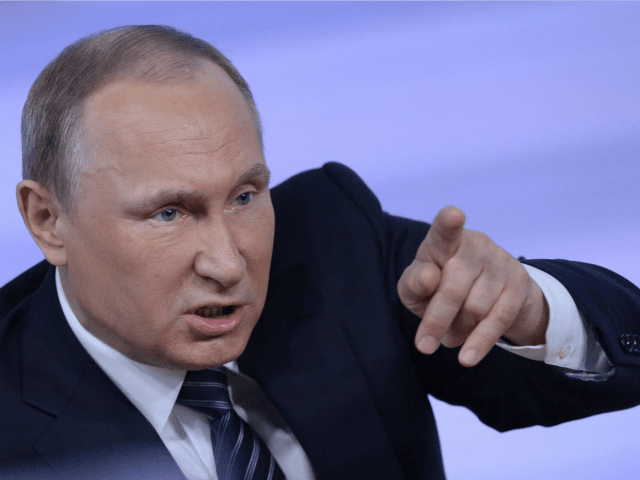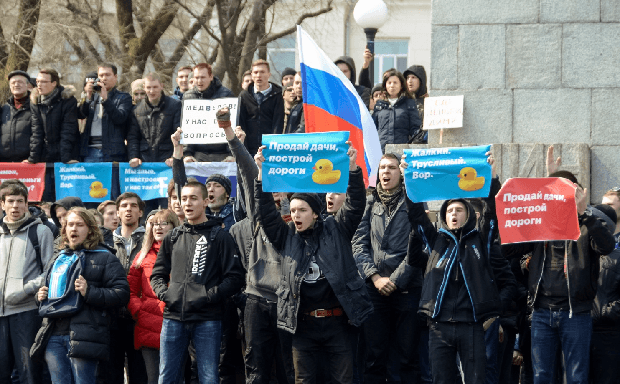Protests swept through a hundred cities and towns in Russia over the weekend, leading to a number of arrests, including opposition leader Alexei Navalny – a likely opponent for President Vladimir Putin in next year’s elections.
According to CNN, the protests seem to have been largely inspired by a YouTube video Navalny and his Anti-Corruption Foundation posted on the “corruption empire” of Prime Minister Dmitry Medvedev. The video has pulled over 13 million views since it was uploaded on March 2nd. A subtitled version of the 50-minute video appears below:
Among the video’s revelations are that Medvedev has an absurdly elaborate duck house at his summer mansion, a property that turns out to be 40 times larger than previously believed. He is also said to have a fondness for expensive footwear; Navalny’s group claims it found some of his property holdings by tracking shipments of high-end running shoes. This is why rubber ducks and old sneakers figured prominently as props in the weekend demonstrations.
Other demonstrators painted their faces green because an unidentified assailant sprayed green fluid in Navalny’s face while he was walking the streets of Barnaul in Siberia last week. Navalny’s response to that incident on Twitter was, “I will be opening a headquarters in Barnaul as if I am from the film The Mask! Cool. Even my teeth are green!”
The weekend protests were unexpectedly huge, with thousands turning out in St. Petersburg, Vladivostok, and Moscow. The Associated Press reports 5,000 demonstrators in St. Petersburg and 8,000 in Moscow but allows that the crowds could have been larger than these official police estimates. The UK Guardian cites an estimate from Russian radio station Ekho Moskvy that 60,000 Russians from 82 cities and towns participated in the protests. There appears to be a consensus they were the biggest protests faced by the Kremlin since 2011.
Varying estimates by police and human-rights groups said anywhere from 500 to over 1,000 people were detained over the weekend. One of them was Navalny, who promptly posted a selfie of his arrival in the courtroom on Twitter. “Hello everyone from Tverskoy Court. The time will come when we will have them on trial (only honestly),” he wrote.
“Hi, everything is fine with me. I’m at the police station and we’re talking about the film with the police. Keep up your peaceful walk, the weather is good,” read another tweet from Navalny to his followers.
Navalny spent the night in jail, charged with staging an illegal demonstration and disobeying police orders. The first charge has reportedly been dropped, but his lawyer is appealing a 15-day sentence for disobeying the police. The Guardian reports that protesters tried to block the police bus that carted him away from the Moscow rally but were “beaten away by riot police.”
One of the Guardian’s reporters was detained while photographing police actions and threatened with charges for “participating in an unsanctioned protest,” but was later released. Several demonstrators complained of police brutality to the Guardian, including a 15-year-old boy who said he was kicked in the face.
“Perhaps the most striking thing about the protests that swept Russia this weekend was the make-up of the crowd which included significant numbers of young people, even schoolchildren,” the BBC observes:
The Kremlin’s spokesman has criticized organizers for luring them onto the streets, claiming they were paid to turn out. Silent until he spoke, state TV channels have picked up that suggestion and run with it.
But these were young Russians who have grown up under Vladimir Putin on a diet of patriotism. On Sunday, they joined a crowd chanting “Putin – thief” and “Russia will be free!”
Their presence is proof of how effectively Alexei Navalny and his team use social media.
The European Union called for the release of all demonstrators and castigated Russian police for preventing “the exercise of basic freedoms of expression, association, and peaceful assembly, which are fundamental rights enshrined in the Russian constitution.”
“The Russian people, like people everywhere, deserve a government that supports an open marketplace of ideas, transparent and accountable governance, equal treatment under the law, and the ability to exercise their rights without fear of retribution,” said U.S. State Department spokesman Mark Toner.
Medvedev spokespeople have dismissed Navalny’s corruption allegations as “propagandistic attacks.” State-run media staged a cartoonishly obvious blackout of news on the enormous demonstrations, a move that will probably be viewed with contempt by Navalny’s Internet-savvy young supporters. Virtually every analyst currently sees Putin as a lock for re-election with sky-high approval ratings, but there seems to be growing unease that Navalny’s anti-corruption platform is more popular than the Kremlin expected.
“We cannot respect people who knowingly mislead the underage kids, in fact, asking them, while promising some sort of rewards, to participate in an illegal event,” said Kremlin spokesman Dmitri Peskov, who went on to risibly claim that all of Russia’s state-run media outlets spontaneously and randomly decided not to cover the protests.
One other tool is available to the Kremlin for dealing with Navalny: he was recently retried on embezzlement charges from 2013 and given a suspended sentence, which he denounced as “a cable from the Kremlin that says they consider us too dangerous to let us run in the presidential election.” His brother Oleg Navalny is currently jailed on corruption charges, and having very little luck at parole hearings.
In theory, Alexey Navalny’s suspended sentence prevents him from running for president, and it would not be difficult for the government to claim his involvement with unpermitted protests merits switching the sentence to active and jailing him. The big question for the Kremlin is whether taking such action would make him more, or less, popular.


COMMENTS
Please let us know if you're having issues with commenting.